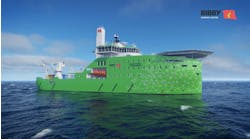Stolt Offshore’s laybarge LB 200 is approaching the halfway point on the world’s longest subsea trunkline installation.
Its program for the Ormen Lange gas development in the Norwegian Sea is in two parts: the 362-km Langeled line following a route south from Nyhamna, via the Norwegian trench, to the Sleipner production complex; and the 540-km stretch southwest to Easington on the English east coast.
The vessel was designed and built by Gusto in the early 1970s for harsh-environment, large-diameter pipeline installations, and was a regular fixture in the North Sea until recently. Ormen Lange is its first major assignment in this sector for several years. The LB 200 measures 167.5 m long, 58.5 m wide and 33.2 m high, and features two double-jointing lines for one main firing line, with five welding stations, one X-ray station, and two pipe-coating stations.
To meet the demands of handling huge quantities of pipe for this project - in particular, the operating rules of the Norwegian Maritime Directorate - Stolt commissioned Schiedam-based Gusto for engineering assistance, including supply and installation of various steel structures for the vessel’s four pipe-handling gantry cranes. Refurbishment was made easier through the fact that Gusto had kept all the vessel’s original design files and subsequently compiled documentation.
The refurbished LB 200 at work on the Langeled line.
For the crane gantries and trolleys, the program involved design and supply of enlarged counter rollers with load-measuring shear pins, reinforcements for the main girders, uplift hooks and horizontal guides on the gantry bogeys, new gantry crane wheels, and local steel reinforcements.
During activity on the gantry cranes, one starboard crane and one portside crane remained operational, which allowed a fully sequential work schedule to be carried out. Much of the work had to be done during winter, which meant that the crew had to operate under covered tents in several locations.
Due to safety concerns arising from the large number of construction personnel on the vessel, Gusto also conducted risk assessment relating in particular to the temporary gantry crane scaffolding. To avoid delays, Gusto provided its own generating sets, welding equipment and other machines. By mid-June, according to Gusto, the vessel had installed 10,000 pipe joints without suffering any downtime.
Zaandam-based Kenz Cranes, which was contracted by Stolt Offshore for the upgrade program, designed and supplied a heave compensation system to stabilize the cranes during transfer of pipes from the supply vessel to the LB 200’s deck. The cranes can now perform this job at a lifting speed of 4m/sec, even in choppy conditions.•




